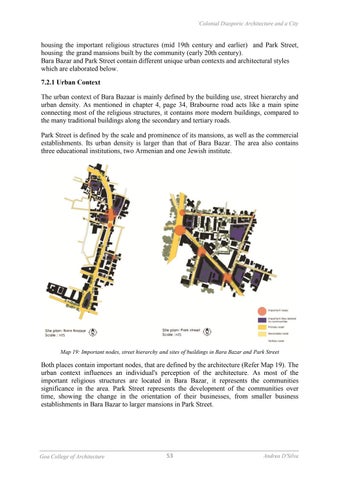`Colonial Diasporic Architecture and a City
housing the important religious structures (mid 19th century and earlier) and Park Street, housing the grand mansions built by the community (early 20th century). Bara Bazar and Park Street contain different unique urban contexts and architectural styles which are elaborated below. 7.2.1 Urban Context The urban context of Bara Bazaar is mainly defined by the building use, street hierarchy and urban density. As mentioned in chapter 4, page 34, Brabourne road acts like a main spine connecting most of the religious structures, it contains more modern buildings, compared to the many traditional buildings along the secondary and tertiary roads. Park Street is defined by the scale and prominence of its mansions, as well as the commercial establishments. Its urban density is larger than that of Bara Bazar. The area also contains three educational institutions, two Armenian and one Jewish institute.
NTS
NTS
Map 19: Important nodes, street hierarchy and sites of buildings in Bara Bazar and Park Street
Both places contain important nodes, that are defined by the architecture (Refer Map 19). The urban context influences an individual's perception of the architecture. As most of the important religious structures are located in Bara Bazar, it represents the communities significance in the area. Park Street represents the development of the communities over time, showing the change in the orientation of their businesses, from smaller business establishments in Bara Bazar to larger mansions in Park Street.
Goa College of Architecture
53
Andrea D'Silva



















